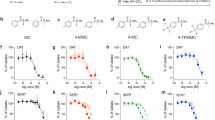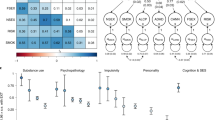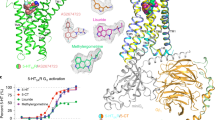Abstract
Serotonergic abnormalities may be present in individuals with either substance dependence (SD) or antisocial personality disorder (ASPD), disorders that occur together commonly. Consequently, genes encoding serotonin (5-HT) receptors are candidates for genetic studies of both disorders. Lappalainen et al. (1998) found evidence for linkage of antisocial alcoholism to HTR1B (the locus encoding the 5-HT1B receptor) in both Finns and Southwestern American Indians, and of allelic association of a G861C polymorphism at that locus with antisocial alcoholism in Finns. Unless the G861C polymorphism is found to be functional, it must be in linkage disequilibrium (LD) with a functional variant for it to be of physiological significance. Methods: The present study evaluated LD across three polymorphic systems at HTR1B and haplotype frequencies and allelic association of these systems with both SD generally and alcohol dependence (AD) specifically, with or without a comorbid antisocial diagnosis. Subjects were 370 European Americans (EAs) and 123 African Americans (AAs). Results: Although there was strong evidence for LD across polymorphic systems in both populations, there was no evidence for association to SD or AD, either alone or with a comorbid antisocial diagnosis. Conclusion: Despite no evidence in this study for allelic association of HTR1B to antisocial substance dependence, further evaluation of the hypothesized association is warranted in other population groups.
Similar content being viewed by others
Log in or create a free account to read this content
Gain free access to this article, as well as selected content from this journal and more on nature.com
or
References
Adham N, Romanienko P, Hartig P, Weinshank RL, Branchek T . (1992): The rat 5-hydroxytryptamine-1B receptor is the species homologue of the human 5-hydroxytryptamine-1D beta receptor. Mol Pharmacol 41: 1–7
American Psychiatric Association. (1987): Diagnostic and Statistical Manual of Mental Disorders Third Edition, revised Washington DC, American Psychiatric Press
Babor TF, Hofmann M, DelBoca FK, Hesselbrock V, Meyer RE, Dolinsky ZS, Rounsaville B . (1992): Types of alcoholics, I. Evidence for an empirically derived typology based on indicators of vulnerability and severity. Arch Gen Psychiatry 49: 599–608
Ball SA, Carroll KM, Babor TF, Rounsaville BJ . (1995): Subtypes of cocaine abusers: support for a type A-type B distinction. J Consult Clin Psychol 63: 115–124
Ball SA, Kranzler HR, Tennen H, Poling JC, Rounsaville BJ . (1998): Personality disorder and dimension differences between type A and type B substance abusers. J Pers Dis 12: 1–12
Blouin AG, Perez EL, Blouin JH . (1988): Computerized administration of the diagnostic interview schedule. Psychiatr Res 23: 335–344
Bohman M, Cloninger R, Sigvardsson S, von Knorring AL . (1987): The genetics of alcoholisms and related disorders. J Psychiatric Res 21: 447–452
Brodie MS, Bunney EB . (1996): Serotonin potentiates dopamine inhibition of ventral tegmental area neurons in vitro. J Neurophysiol 76: 2077–2082
Cadoret RJ, Troughton E, O'Gorman TW, Heywood E . (1986): An adoption study of genetic and environmental factors in drug abuse. Arch Gen Psychiatry 43: 1131–1136
Cadoret RJ, Yates WR, Troughton E, Woodworth G, Stewart MA . (1995): Adoption study demonstrating two genetic pathways to drug abuse. Arch Gen Psychiatry 52: 42–52
Cargill M, Altshuler D, Ireland J, Sklar P, Ardlie K, Patil N, Lane CR, Lim EP, Kalyanaraman N, Nemesh J, Ziaugra L, Friedland L, Rolfe A, Warrington J, Lipshutz R, Daley GQ, Lander ES . (1999): Characterization of single-nucleotide polymorphisms in coding regions of human genes. Nat Genet 22: 231–238
Cleare AJ, Bond AJ . (1995): The effect of tryptophan depletion and enhancement on subjective and behavioral aggression in normal male subjects. Psychopharmacol 118: 72–81
Crabbe JC, Belknap JK, Buck KJ . (1994): Genetic animal models of alcohol and drug abuse. Science 264: 1715–1723
Crabbe JC, Phillips TJ, Feller DJ, Hen R, Wenger CD, Lessov CN, Schafer GL . (1996): Elevated alcohol consumption in null mutant mice lacking 5-HT1B serotonin receptors. Nat Genet 14: 98–101
Demchyshyn L, Sunahara RK, Miller K, Teitler M, Hoffman BJ, Kennedy JL, Seeman P, Van Tol HH, Niznik HB . (1992): A human serotonin 1D receptor variant (5HT1D beta) encoded by an intronless gene on chromosome 6. Proc Natl Acad Sci USA 89: 5522–5526
Di Chiara G, Imperato A . (1988): Drugs abused by humans preferentially increase synaptic dopamine concentrations in the mesolimbic system of freely moving rats. Proc Natl Acad Sci 85: 5274–5278
Falk CT, Rubinstein P . (1987): Haplotype relative risks: An easy reliable way to construct a proper control sample for risk calculations. Ann Hum Genet 51: 227–233
Feingold A, Ball SA, Kranzler HR, Rounsaville BJ . (1996): Generalizability of the type A/type B Distinction across different psychoactive substances. Am J Drug Alcohol Abuse 22: 449–462
Higley JD, Mehlman PT, Taub DM, Higley SB, Suomi SJ, Linnoila M, Vickers JH . (1992): Cerebrospinal fluid monoamine and adrenal correlates of aggression in free-ranging rhesus monkeys. Arch Gen Psychiatry 49: 436–441
Higley JD, Suomi SJ, Linnoila M . (1996): A nonhuman primate model of type II excessive alcohol consumption? Part 2. Diminished social competence and excessive aggression correlates with low cerebrospinal fluid 5-hydroxyindolacetic acid concentrations. Alcohol Clin Exp Res 20: 643–650
Huang Y, Grailhe R, Arango V, Hen R, Mann J . (1999): Relationship of psychopathology to the human serotonin 1B genotype and receptor binding kinetics in postmortem brain tissue. Neuropsychopharmacol 21: 238–246
Julius D . (1991): Molecular biology of serotonin receptors. Annual Review of Neuroscience 14: 335–360
Kessler RC, McGonagle KA, Zhao S, Nelson CB, Hughes M, Eshleman S, Wittchen H-U, Kendler KS . (1994): Lifetime and 12-month prevalence of DSM-III-R psychiatric disorders in the United States: Results from the National Comorbidity Survey. Arch Gen Psychiatry 51: 8–19
Kessler RC, Nelson CB, McGonagle KA, Edlund MJ, Frank RG, Leaf PJ . (1996): The epidemiology of co-occurring addictive and mental disorders: implications for prevention and service utilization. Am J Orthopsychiatry 66: 17–31
Kriem B, Abraini JH, Rostain JC . (1996): Role of 5-HT1b receptor in the pressure-induced behavioral and neurochemical disorders in rats. Pharmacol Biochem Behav 53: 257–264
Lappalainen J, Dean M, Charbonneau L, Virkkunen M, Linnoila M, Goldman D . (1995): Mapping of the serotonin 5-HT1D beta autoreceptor gene on chromosome 6 and direct analysis for sequence variants. Am J Med Genet 60: 157–161
Lappalainen J, Long JC, Eggert M, Ozaki N, Robin RW, Brown GL, Naukkarinen H, Virkkunen M, Linnoila M, Goldman D . (1998): Linkage of antisocial alcoholism to the serotonin 5-HT1B receptor gene in two populations. Arch Gen Psychiatry 55: 989–994
Lewis PO, Zaykin D . (2000): Genetic Data Analysis: Computer program for the analysis of allelic data Version 1.0 (d15). Free program distributed by the authors over the internet from the GDA Home Page at http://alleyn.eeb.uconn.edu/gda/
Lewis PO, Zaykin D . (2001): Genetic data analysis Computer program for the analysis of allelic data. Version 1.0 (d16c). Free program distributed by the authors over the internet from http://lewis.eeb.uconn.edu/lewishome/software.html
Lewontin R . (1988): On measures of gametic disequilibrium. Genetics 120: 849–852
Limson R, Goldman D, Roy A, Lamparski D, Ravitz B, Adinoff B, Linnoila M . (1991): Personality and cerebrospinal fluid monoamine metabolites in alcoholics and controls. Arch Gen Psychiatry 48: 437–441
Long JC, Williams RC, Urbanek M . (1995): An E-M algorithm and testing strategy for multiple-locus haplotypes. Am J Hum Genet 56: 799–810
Maroteaux L, Saudou F, Amlaiky N, Boschert U, Plassat JL, Hen R . (1992): Mouse 5HT1B Serotonin receptor: cloning, functional expression, and localization in motor control centers. Proc Natl Acad Sci 89: 3020–3024
Moss HB, Yao JK, Panzak GL . (1990): Serotoninergic responsivity and behavioral dimensions in antisocial personality disorder with substance abuse. Biol Psychiatry 28: 325–338
Mundo E, Richter MA, Sam F, Macciardi F, Kennedy JL . (2000): Is the 5-HT(1Dbeta) receptor gene implicated in the pathogenesis of obsessive-compulsive disorder?. Am J Psychiatry 157: 1160–1161
Nöthen MM, Erdmann J, Shimron-Abarbanell D, Propping P . (1994): Identification of genetic variation in the human serotonin 1D beta receptor gene. Biochem Biophys Res Commun 205: 1194–1200
O'Keane V, Moloney E, O'Neill H, O'Vonner A, Smith C, Dinan TG . (1992): Blunted prolactin responses to D-fenfluramine in sociopathy: Evidence for subsensitivity of central serotoninergic function. Br J Psychiatry 160: 643–646
Parsons LH, Weiss F, Koob GF . (1998): Serotonin 1B receptor stimulation enhances cocaine reinforcement. J Neurosci 18: 10078–10089
Pihl RO, Young SN, Harden P, Plotnick S, Chamberlain B, Ervin FR . (1995): Acute effect of altered tryptophan levels and alcohol on aggression in normal human males. Psychopharmacol 119: 353–360
Pritchard JK, Rosenberg NA . (1999): Use of unlinked genetic markers to detect population stratification in association studies. Am J Hum Genet 65: 220–228
Pritchard JK, Stephens M, Rosenberg NA, Donnelly P . (2000): Association mapping in structured populations. Am J Hum Genet 67: 170–181
Regier DA, Farmer ME, Rae DS, Locke BZ, Keith SJ, Judd LL, Goodwin FK . (1990): Comorbidity of mental disorders with alcohol and other drug abuse. Results from the Epidemiologic Catchment Area (ECA) Study. JAMA 264: 2511–2518
Rocha BA, Scearce-Levie K, Lucas JJ, Hiroi N, Castanon N, Crabbe JC, Nestler EJ, Hen R . (1998a): Increased vulnerability to cocaine in mice lacking the serotonin-1B receptor. Nature 393: 175–178
Rocha BA, Fumagalli F, Gainetdinov RR, Jones SR, Ator R, Giros B, Miller GW, Caron MG . (1998b): Cocaine self-administration in dopamine-transporter knockout mice. Nature Neurosci 1: 132–137
Saudou F, Amara DA, Dierich A, LeMeur M, Ramboz S, Segu L, Buhot MC, Hen R . (1994): Enhanced aggressive behavior in mice lacking 5-HT1B receptor. Science 265: 1875–1878
Sidenberg DG, Bassett AS, Demchyshyn L, Niznik HB, Macciardi F, Kamble AB, Honer WG, Kennedy JL . (1993): New polymorphism for the human serotonin 1D receptor variant (5-HT1D beta) not linked to schizophrenia in five Canadian pedigrees. Hum Hered 43: 315–318
Soubrie P . (1986): Reconciling the role of central serotonin neurons in human and animal behavior. Behav Brain Sci 9: 319–364
Spielman RS, McGinnis RE, Ewens WJ . (1993): Transmission test for linkage disequilibrium: the insulin gene region and insulin-dependent diabetes mellitus (IDDM). Am J Hum Genet 52: 506–516
Spitzer RL, Endicott J . (1975): Schedule for Affective Disorders and Schizophrenia: Lifetime version New York Biometrics Research Division, New York State Psychiatric Institute
Spitzer RL, Williams JBW, Gibbon M, First MB . (1992): The Structured Clinical Interview for DSM-III-R (SCID), I: History, rationale and description. Arch Gen Psychiatry 49: 624–629
Verheul R, Ball SA, van den Brink W . (1998): Substance abuse and personality disorders. In Kranzler HR, Rounsaville BJ (eds), Dual Diagnosis and Treatment: Substance Abuse and Comorbid Medical and Psychiatric Disorders. New York, Marcel Dekker, 317–363
Virkkunen M, Rawlings R, Tokola R, Poland RE, Guidotti A, Nemeroff C, Bissette G, Kalogeras K, Karonen S-L, Linnoila M . (1994): CSF biochemistries, glucose metabolism, and diurnal activity rhythms in alcoholic violent offenders, fire setters, and healthy volunteers. Arch Gen Psychiatry 51: 20–27
Voigt MM, Laurie DJ, Seeburg PH, Bach A . (1991): Molecular cloning and characterization of a rat brain cDNA encoding a 5-hydroxytryptamine1B receptor. EMBO J 10: 4017–4023
Weir BS . (1996): Genetic Data Analysis II Methods for Discrete Population Genetic Data Sunderland, MA, Sinauer Associates
Zifa E, Fillion G . (1992): 5-Hydroxytryptamine receptors. Pharmacological Reviews 44: 401–458
Acknowledgements
J. Lappalainen, M.D., Ph.D., made helpful comments on the manuscript. A. Lacobelle, R. Capper, P. Fall, C. Petrus, K. Bonvicini, and K. Beazoglou provided excellent technical assistance. This work was supported by funds from the U.S. Department of Veterans Affairs (the VA Medical Research Program and the VA Connecticut-Massachusetts Mental Illness Research, Education and Clinical Center (MIRECC)), NIMH grant K02-MH01387, NIAAA grants R01-AA11330, K02-AA00239, and P50-AA03510, and NCRR grant M01-RR06192 (University of Connecticut General Clinical Research Center).
Author information
Authors and Affiliations
Corresponding author
Rights and permissions
About this article
Cite this article
Kranzler, H., Hernandez-Avila, C. & Gelernter, J. Polymorphism of the 5-HT1B Receptor Gene (HTR1B): Strong Within-Locus Linkage Disequilibrium without Association to Antisocial Substance Dependence. Neuropsychopharmacol 26, 115–122 (2002). https://doi.org/10.1016/S0893-133X(01)00283-4
Received:
Revised:
Accepted:
Published:
Issue date:
DOI: https://doi.org/10.1016/S0893-133X(01)00283-4
Keywords
This article is cited by
-
Brain serotonin receptors and transporters: initiation vs. termination of escalated aggression
Psychopharmacology (2011)
-
HTR1B as a risk profile maker in psychiatric disorders: a review through motivation and memory
European Journal of Clinical Pharmacology (2010)
-
A common polymorphism in serotonin receptor 1B mRNA moderates regulation by miR-96 and associates with aggressive human behaviors
Molecular Psychiatry (2009)
-
Identification of QTLs Influencing Alcohol Preference in the High Alcohol Preferring (HAP) and Low Alcohol Preferring (LAP) Mouse Lines
Behavior Genetics (2006)
-
The genetics of addictions: uncovering the genes
Nature Reviews Genetics (2005)



